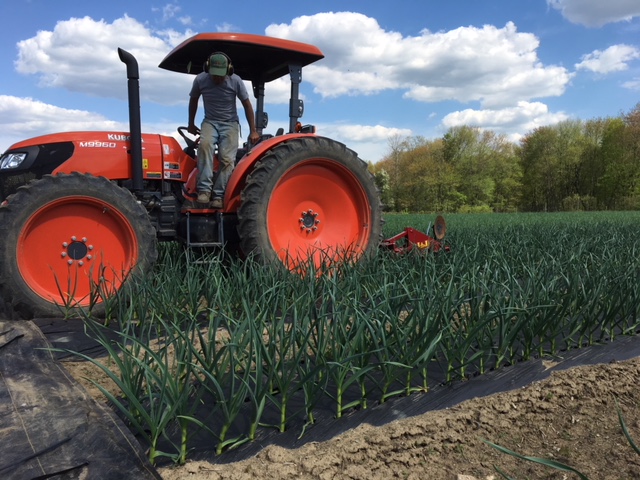We’re back! And we have GARLIC!
Garlic is something most of us see year-round in the grocery store. It’s one of those crops that we don’t always think of as being “seasonal”, or having a “season”. But follow any farmer’s social media account, and you’ll pretty quickly see that garlic does indeed have a season: and that harvest season is July.
Our garlic’s story begins in October of last year, when we planted it into a layer of plastic mulch. (The plastic mulch helps retain moisture, suppress weeds, and warm the soil in the spring.) The garlic must undergo a cold period in order to form a nice fat bulb -- and so it spends the winter out in the ground, waiting for spring.
Garlic shoots in March
Cultivating the garlic in May
In March, as the soil warms, the garlic sends up little green shoots… and soon, so do lots of weeds. Weeds like grasses, that threaten to spread their dense, deep root systems and steal all of the garlic’s nutrients, and amaranth and lamb’s quarter, whose big wide leaves will take up all the sunlight and shade out the garlic. So we weed. We cultivate the pathways with the tractor, we hoe the sides that the tractor missed, and we weed the holes with our hands. We do this more than once. With careful weeding and watering, the garlic sizes up.
By the time it’s about waist-high, in early June, plants start to send up tall, squiggly poles from the center: the scapes! If left to mature, the arrow-shaped tips of the scapes will swell to create a bundle of mini-bulbs, called “bulbils” -- and will draw on nutrients stored underground, in the cloves, to do so. In order to get fat juicy bulbs, we harvest the scapes in June. This forces the plant, which wants to make viable seed, to go to Plan B (the bulb).
A forgotten garlic scape swells with bulbils
The garlic field starting to senesce
Leon showing clove separation during a field walk
From June to July, the green leaves of the garlic plants start to turn yellow and brown at the tips. This process, called senescence, is one of the first indicators that harvest time is approaching. On a recent field walk, Leon showed us another, more reliable indicator: after pulling a bulb from the ground, he sliced it in half crosswise, revealing the hard neck. As cloves mature, they begin to pull away from the neck, leaving tiny gaps of space. At this point, the garlic is pungent and fat and ready to harvest!
Garlic harvest!
Covering garlic with burlap to prevent sunburn
We harvested our garlic on a hot day in July. The plants were mowed to remove the tops, undercut with the tractor to loosen the bulbs, gathered up by farm crew and workshare members, and laid out on tables to cure in the greenhouse. The curing process, which can take one to two weeks, allows the wrapper layers to dry out. Cured garlic can store for many months, though the flavor will evolve and the cloves will become slightly drier and less juicy over time. (Enjoy them now, while they’re fresh -- and notice the change in flavor over the course of the season.)
From this year’s garlic harvest, we will sort out the largest cloves, which will themselves become the garlic harvest of 2019.
Garlic curing in the greenhouse









